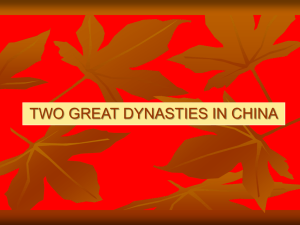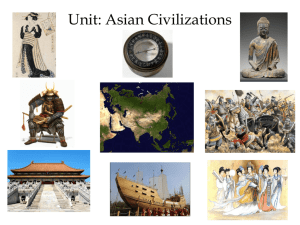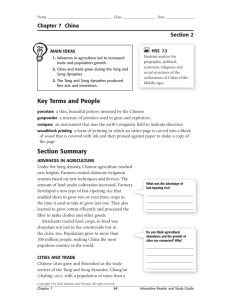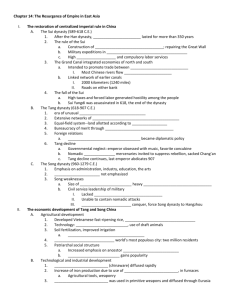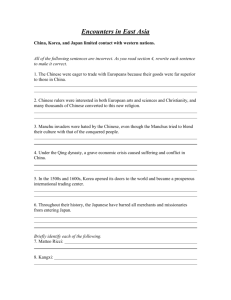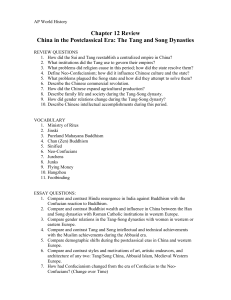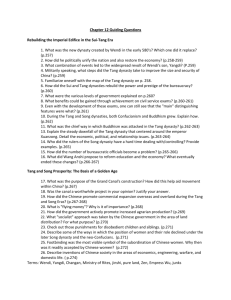Tang & Song China: Golden Age DBQ
advertisement
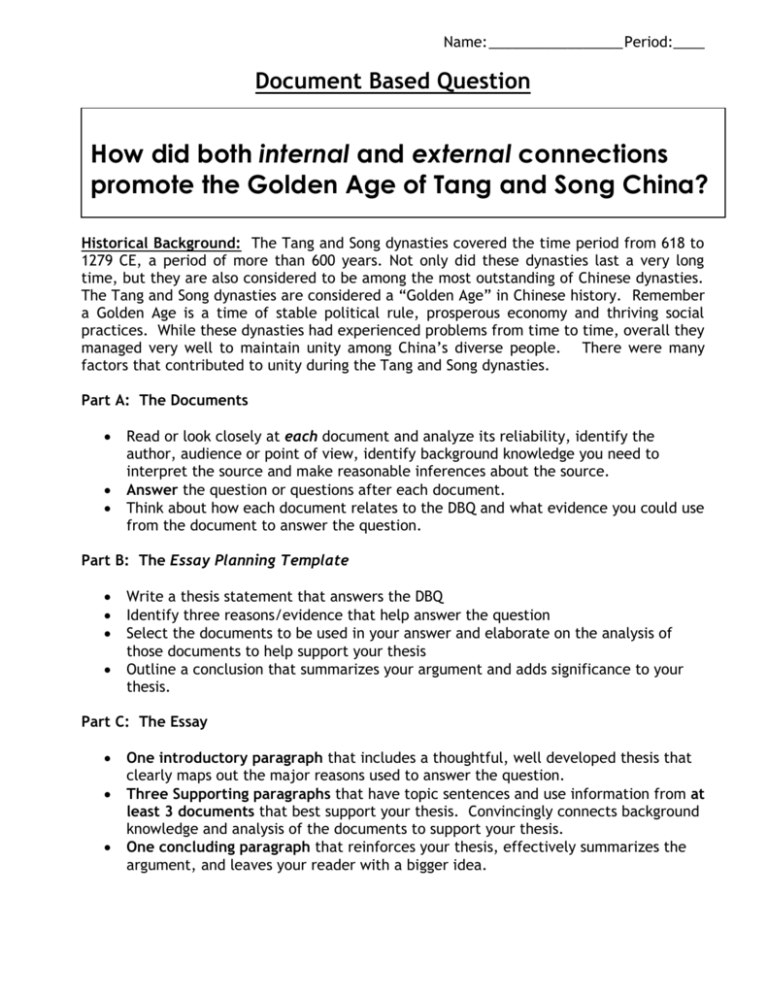
Name: _________________ Period:____ Document Based Question How did both internal and external connections promote the Golden Age of Tang and Song China? Historical Background: The Tang and Song dynasties covered the time period from 618 to 1279 CE, a period of more than 600 years. Not only did these dynasties last a very long time, but they are also considered to be among the most outstanding of Chinese dynasties. The Tang and Song dynasties are considered a “Golden Age” in Chinese history. Remember a Golden Age is a time of stable political rule, prosperous economy and thriving social practices. While these dynasties had experienced problems from time to time, overall they managed very well to maintain unity among China’s diverse people. There were many factors that contributed to unity during the Tang and Song dynasties. Part A: The Documents Read or look closely at each document and analyze its reliability, identify the author, audience or point of view, identify background knowledge you need to interpret the source and make reasonable inferences about the source. Answer the question or questions after each document. Think about how each document relates to the DBQ and what evidence you could use from the document to answer the question. Part B: The Essay Planning Template Write a thesis statement that answers the DBQ Identify three reasons/evidence that help answer the question Select the documents to be used in your answer and elaborate on the analysis of those documents to help support your thesis Outline a conclusion that summarizes your argument and adds significance to your thesis. Part C: The Essay One introductory paragraph that includes a thoughtful, well developed thesis that clearly maps out the major reasons used to answer the question. Three Supporting paragraphs that have topic sentences and use information from at least 3 documents that best support your thesis. Convincingly connects background knowledge and analysis of the documents to support your thesis. One concluding paragraph that reinforces your thesis, effectively summarizes the argument, and leaves your reader with a bigger idea. Part A: Critical Response Questions Document #1: 1. Using the title and chart above, explain the meaning of cultural diffusion. 2. Why does the illustration above support the idea that Tang and Song China was experiencing a Golden Age at this time? Document #2: Geographic and Economic Information Items Traded West to East Garlic Grapevine Spices Spinach Cotton Herbal medicines Horses Camels Gems, gold and silver Ivory Items Traded East to West Silk Porcelain Technology and Inventions Compass Paper Gun Powder Question: 1. In general, how did the types of items traded East (from China) to West differ from the types of items traded West to East? 2. Use information provided above and your own understandings to explain how successful trade along the Silk Road helped China achieve a Golden Age. Explain at least two ways. Document #3: Questions: 1. According to the chart, which levels of Chinese government have power over all people? 2. Based on what is shown in the chart, make two points explaining how there is an opportunity for social mobility (movement of people) in this class structure. Document #4: Technological Inventions & Cultural Innovations of Tang and Song China Invention Date Description Impact Gun Powder 900 CE First used for fireworks, then weapons, technology spread west within 300 years. Magnetic Compass (for navigation) 1100 CE Mechanical clock 725 CE Explosive powder made from mixture of saltpeter, Sulfur, and charcoal Floating magnetized needle that always points north-south; device had existed in China for centuries before it was adapted by sailors for use at sea Clock in which machinery (driven by running water) regulated the movements Paper money 960 CE Porcelain 600 CE Printing Block printing: 735 CE Paper currency issued by Song government to replace cumbersome strings of metal cash used by merchants Bone-hard white ceramic made of a special clay and a mineral found only in China Block printing; one block on which a whole page is cut Helped China become a sea power; technology quickly spread west Early Chinese clocks short –lived; idea for mechanical clock carried by traders to medieval Europe Contributed to development of largescale commercial economy in China Became a valuable export-so associated with Chinese culture that it is now called “china”, technology remained a Chinese secret for centuries Printing technology spread to Korea and Japan 1. Pick two inventions of the Tang and Song Dynasties and explain how they helped China achieve a “Golden Age”. 2. How would the two inventions you chose influence the rest of the medieval world? Document #6: “The basic justification for the Chinese Imperial (civil service) Exams was that appointees to civil service positions were not to be chosen through special or inherited privilege, but through an individual's own abilities. For centuries, the might of China was established militarily, often by emperors from humble origins who had toppled existing dynasties. However, once in control, these emperors soon realized that the actual governance of China would require the administrative services of thousands of bureaucrats. The civil service examination was thus a means for creating such a body of men…” http://www.csupomona.edu/~plin/ls201/confucian3.html Document #7: “The examination system also helped to maintain cultural unity and agreement on basic values. The fact that the content of the examinations were uniform (did not vary) meant that the local scholars and ambitious would-be scholars across the whole of China were taught with the same values. Even though only a small fraction (about 5 percent) of those who attempted the examinations passed them and received titles, the studying and the hope of eventual success on a another examination sustained the interest of those who took them. Those who failed to pass—most of the candidates at any single examination—did not lose wealth or local social standing; as dedicated believers in Confucian ideals, they served, without the benefit of state appointments, as teachers, patrons (supporters)of the arts, and managers of local projects, such as irrigation works, schools, or charitable foundations.” http://en.wikipedia.org/wiki/Imperial_examination Questions: Examine both documents. 1. According to Document #6, what was needed—in addition to a powerful Emperor—to successfully rule China? 2. Using information from both documents above, explain how civil service examinations helped China achieve a Golden Age. Describe at least two ways. Part B: Essay Planning Template Thesis: __________________________________________________________ Reason/Evidence #1 Reason/Evidence #2 Reason/Evidence #3 a) Document(s) ___________ a) Document(s) ____________ a) Document(s) ____________ b) Analysis/Explanation b) Analysis/Explanation b) Analysis/Explanation Conclusion (Sum up large concepts using different language. Leave the reader with a greater thought.) Name ____________________ Period _____ Part C: The Essay ______________________________________________________________________________ ______________________________________________________________________________ ______________________________________________________________________________ ______________________________________________________________________________ ______________________________________________________________________________ ______________________________________________________________________________ ______________________________________________________________________________ ______________________________________________________________________________ ______________________________________________________________________________ ______________________________________________________________________________ ______________________________________________________________________________ ______________________________________________________________________________ ______________________________________________________________________________ ______________________________________________________________________________ ______________________________________________________________________________ ______________________________________________________________________________ ______________________________________________________________________________ ______________________________________________________________________________ ______________________________________________________________________________ ______________________________________________________________________________ ______________________________________________________________________________ ______________________________________________________________________________ ______________________________________________________________________________ ______________________________________________________________________________ ______________________________________________________________________________ ______________________________________________________________________________ ______________________________________________________________________________ ______________________________________________________________________________ ______________________________________________________________________________ ______________________________________________________________________________ ______________________________________________________________________________ ______________________________________________________________________________ ______________________________________________________________________________ ______________________________________________________________________________ ______________________________________________________________________________ ______________________________________________________________________________ ______________________________________________________________________________ ______________________________________________________________________________ ______________________________________________________________________________ ______________________________________________________________________________ ______________________________________________________________________________ ______________________________________________________________________________ ______________________________________________________________________________ ______________________________________________________________________________ ______________________________________________________________________________ ______________________________________________________________________________ ______________________________________________________________________________ ______________________________________________________________________________ ______________________________________________________________________________ ______________________________________________________________________________ ______________________________________________________________________________ ______________________________________________________________________________ ______________________________________________________________________________ ______________________________________________________________________________ ______________________________________________________________________________ ______________________________________________________________________________ China DBQ Key Part A: Critical Response Questions Document #1: 3. Using the title and chart above, explain the meaning of cultural diffusion. (2) Culture spreads from a dominant civilization to new territories. Parts of the dominant culture are absorbed by the new culture. 4. Why does the illustration above support the idea that Tang and Song China was experiencing a Golden Age at this time? (4) The arrow clearly indicates that the idea of centralized government, a cultural institution, is leaving China and showing up in Japan, as are advances in agricultural techniques, weights & measurements. China must be advanced in these areas, since other cultures are adapting their systems. Document #2: Geographic and Economic Information Items Traded West to East Garlic Grapevine Spices Spinach Cotton Herbal medicines Horses Camels Gems, gold and silver Ivory Items Traded East to West Silk Porcelain Technology and Inventions Compass Paper Gun Powder Question: 3. In general, how did the types of items traded East (from China) to West differ from the types of items traded West to East? (2) Items traded East to West were manufactured: new inventions, technology, etc. Items traded West to East were organic: food products, medicines, plants, gems, etc. 4. Use information provided above and your own understandings to explain how successful trade along the Silk Road helped China achieve a Golden Age. Explain at least two ways. (4) Exports bring more money and opportunity to people, uniting them. Imported items improve the quality of life. People are connected through trade both in the East and West. Cultural exchanges, sharing ideas occur as people trade. Document #3: Questions: 1. According to the chart, which levels of Chinese government have power over all people? (2) Emperor (and Court) 3. How might an organized social hierarchy (as shown in the chart) better connect people in China? Describe at least two reasons. (4) People have a well-defined role in society, know their boundaries Some mobility in lower levels of societal structure: peasants can gain education, become gentry – Merchants can purchase land, get education, become gentry Many levels have at least some voice in government: Local government structures take care of village needs. Provincial gov’t deals with regional issues. Emperor oversees entire empire. Document #4: Technological Inventions & Cultural Innovations of Tang and Song China Invention Date Description Gun Powder 900 CE Explosive powder made from mixture of saltpeter, Sulfur, and charcoal Magnetic Compass (for navigation) 1100 CE Floating magnetized needle that always points north-south; device had existed in China for centuries before it was adapted by sailors for use at sea Mechanical clock 725 CE Clock in which machinery (driven by running water) regulated the movements Paper money 960 CE Paper currency issued by Song government to replace cumbersome strings of metal cash used by merchants Porcelain 600 CE Bone-hard white ceramic made of a special clay and a mineral found only in China Printing Block printing: 735 CE Block printing; one block on which a whole page is cut 2. Pick two inventions of the Tang and Song Dynasties and explain how they helped China achieve a “Golden Age”. (4) Answers vary: Look for factors like “increased economy”, “promoted exchange of ideas”, ”improved ways to connect to others”, etc. 1. How would the two inventions you chose influence the rest of the world? (4) Answers vary: Look for influences (compass made discovery of new lands possible, promoted trade. Paper money made large-scale trade possible on an international level, etc.) Document #6: “The basic justification for the (Song Dynasty’s) Chinese Imperial Exams was that appointees to civil service positions were not to be chosen through special or inherited privilege, but through an individual's own abilities. For centuries, the might of China was established militarily, often by emperors from humble origins who had toppled existing dynasties. However, once in control, these emperors soon realized that the actual governance of China would require the administrative services of thousands of bureaucrats. The civil service examination was thus a means for creating such a body of men…” http://www.csupomona.edu/~plin/ls201/confucian3.html Document #7: “The examination system also helped to maintain cultural unity and agreement on basic values. The fact that the content of the examinations were uniform (did not vary) meant that the local scholars and ambitious would-be scholars across the whole of China were taught with the same values. Even though only a small fraction (about 5 percent) of those who attempted the examinations passed them and received titles, the studying and the hope of eventual success on a another examination sustained the interest of those who took them. Those who failed to pass—most of the candidates at any single examination—did not lose wealth or local social standing; as dedicated believers in Confucian ideals, they served, without the benefit of state appointments, as teachers, patrons of the arts, and managers of local projects, such as irrigation works, schools, or charitable foundations.” http://en.wikipedia.org/wiki/Imperial_examination Questions: Examine both documents. 4. According to Document #6, what was needed—in addition to a powerful Emperor—to successfully rule China? (2) The administrative services of thousands of bureaucrats. 5. Using information from both documents above, explain how civil service examinations helped China improve internal connections to achieve a Golden Age. Describe at least two ways. (4) Created a body of men to serve as bureaucrats (help run the government)(Doc. 6) Bureaucrats chosen for ability, not special privilege (Doc 6) Values were consistent – everyone encouraged to learn Confucian ideals (Doc 7) All classes held hope of being able to participate, though only about 5% passed exams (Doc 7) Even those who failed the exams served as teachers, managers of local projects, patrons of the arts (Doc 7) Note: Must have example from each document to get full points. Past DBQ Possible Questions Excerpts from Emperor Taizong on Effective Government: Maintaining Military Forces “Weapons and armor are a country’s tools of violence. A warlike country, however huge and safe it may be, will end up declining and endangering its people. Military force cannot be entirely eliminated nor used all the time. Teach people military arts when they are free from farming in order to prepare them when necessary. … Confucius said, “Not teaching people how to fight is the same as discarding them.” Hence military might serves to benefit all of China.” Questions: 1. According to the document, when should military force be used?(2) Military force should be used only when necessary. 2. a.) How could this use of the military force help keep China unified? Use text support as evidence in your answer.(3) Military training allows the Chinese people to defend themselves against invaders. The document says, “Not teaching people how to fight is the same as discarding them.” People are united in their support of a military, which protects them. b.) How might this use of military force weaken the unity of China? Use text support as evidence in your answer. (3) The document says “A warlike country, however huge and safe it may be, will end up declining and endangering its people.” This means that the military should not be overused, or it will cause China to be endangered, and people will disagree with the aggressive actions of the nation. Document #3x Adapted from James Legge, trans, The Sacred Books of China: The Texts of Confucianism The Mandate of Heaven was an idea that served as the basic Chinese explanation for the success and failure of an emperor. Whenever a dynasty fell, the reason offered by China's scholars was that it had lost the right to rule which is given by Heaven alone. Heaven did not mean a personal god but a cosmic force to which humans were responsible. Most historians today agree that the Mandate of Heaven was an invention of the Zhou Dynasty to justify their overthrow of the Shan Dynasty. The king, after all, was the father of his people, and fatherly authority was the basic cement of Chinese society from earliest times. Rebellion against a father, therefore, needed extraordinary justification. Questions: 1. According to the document, what is the Mandate of Heaven? (2) The Mandate of Heaven is the idea that Heaven alone gives an emperor the right to rule. 2. a) How did the Mandate of Heaven justify rebellion against the government? (3) When the rulers are no longer fulfilling the needs of the people, the dynasty can be overthrown. The document says that when the dynasty fell, it was a sign that it had lost the right to rule. b) How did the Mandate of Heaven discourage rebellion against the government? (3) The document says “The king, after all, was the father of his people, and fatherly authority was the basic cement of Chinese society from earliest times. Rebellion against a father, therefore, needed extraordinary justification.” The items traded East to West are, other than rice, manufactured goods, inventions, things that are luxuries, new technologies. The things that are traded West to East are resources, like food and animals. Even gems, gold, and silver are non-manufactured goods. Exports bring more money and opportunity to people, uniting them. Imported items improve the quality of life. People are connected through trade both in the East and West. Cultural exchanges, sharing of ideas occur as people trade. Excerpts from Emperor Taizong on Effective Government: Maintaining Military Forces “Weapons and armor are a country’s tools of violence. A warlike country, however huge and safe it may be, will end up declining and endangering its people. Military force cannot be entirely eliminated nor used all the time. Teach people military arts when they are free from farming in order to prepare them when necessary. … Confucius said, “Not teaching people how to fight is the same as discarding them.” Hence military might serves to benefit all of China.” Questions: 1. According to the document, when should military force be used?(2) Military force should be used only when necessary. 2. a.) How could this use of the military force help keep China unified? Use text support as evidence in your answer.(3) Military training allows the Chinese people to defend themselves against invaders. The document says, “Not teaching people how to fight is the same as discarding them.” People are united in their support of a military, which protects them. b.) How might this use of military force weaken the unity of China? Use text support as evidence in your answer. (3) The document says “A warlike country, however huge and safe it may be, will end up declining and endangering its people.” This means that the military should not be overused, or it will cause China to be endangered, and people will disagree with the aggressive actions of the nation. Document #3 Adapted from James Legge, trans, The Sacred Books of China: The Texts of Confucianism The Mandate of Heaven was an idea that served as the basic Chinese explanation for the success and failure of an emperor. Whenever a dynasty fell, the reason offered by China's scholars was that it had lost the right to rule which is given by Heaven alone. Heaven did not mean a personal god but a cosmic force to which humans were responsible. Most historians today agree that the Mandate of Heaven was an invention of the Zhou Dynasty to justify their overthrow of the Shan Dynasty. The king, after all, was the father of his people, and fatherly authority was the basic cement of Chinese society from earliest times. Rebellion against a father, therefore, needed extraordinary justification. Questions: 1. According to the document, what is the Mandate of Heaven? (2) The Mandate of Heaven is the idea that Heaven alone gives an emperor the right to rule. 2. a) How did the Mandate of Heaven justify rebellion against the government? (3) When the rulers are no longer fulfilling the needs of the people, the dynasty can be overthrown. The document says that when the dynasty fell, it was a sign that it had lost the right to rule. b) How did the Mandate of Heaven discourage rebellion against the government? (3) The document says “The king, after all, was the father of his people, and fatherly authority was the basic cement of Chinese society from earliest times. Rebellion against a father, therefore, needed extraordinary justification.” The items traded East to West are, other than rice, manufactured goods, inventions, things that are luxuries, new technologies. The things that are traded West to East are resources, like food and animals. Even gems, gold, and silver are non-manufactured goods. Exports bring more money and opportunity to people, uniting them. Imported items improve the quality of life. People are connected through trade both in the East and West. Cultural exchanges, sharing of ideas occur as people trade.
